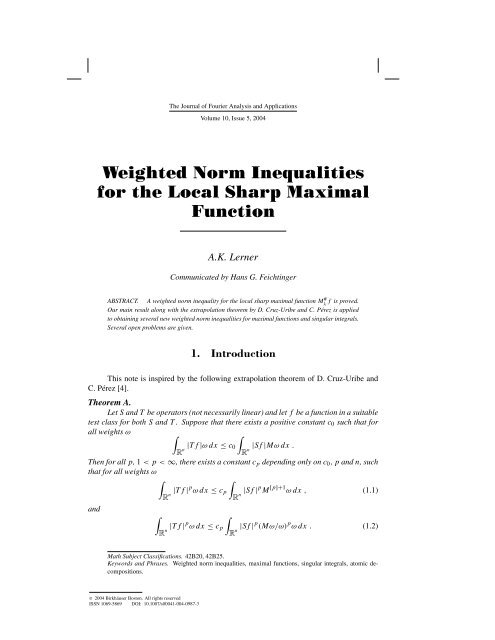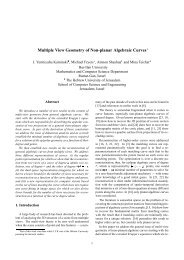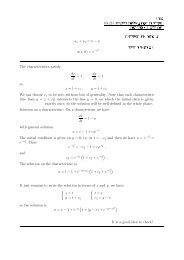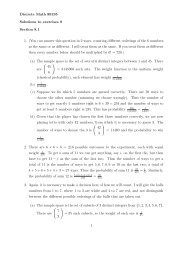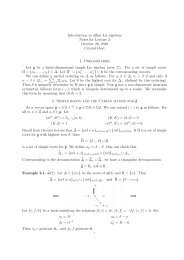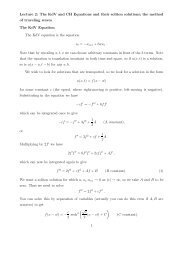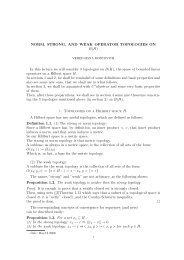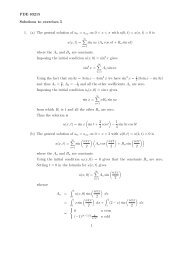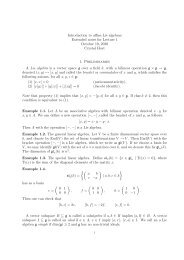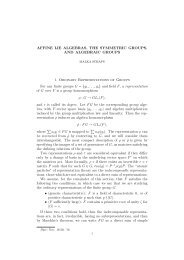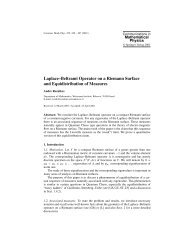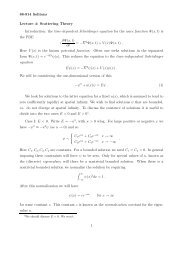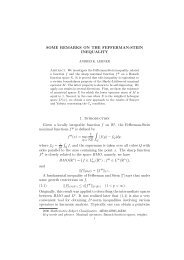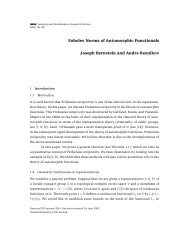Weighted Norm Inequalities for the Local Sharp Maximal Function
Weighted Norm Inequalities for the Local Sharp Maximal Function
Weighted Norm Inequalities for the Local Sharp Maximal Function
You also want an ePaper? Increase the reach of your titles
YUMPU automatically turns print PDFs into web optimized ePapers that Google loves.
The Journal of Fourier Analysis and ApplicationsVolume 10, Issue 5, 2004<strong>Weighted</strong> <strong>Norm</strong> <strong>Inequalities</strong><strong>for</strong> <strong>the</strong> <strong>Local</strong> <strong>Sharp</strong> <strong>Maximal</strong><strong>Function</strong>A.K. LernerCommunicated by Hans G. FeichtingerABSTRACT. A weighted norm inequality <strong>for</strong> <strong>the</strong> local sharp maximal function M λ # f is proved.Our main result along with <strong>the</strong> extrapolation <strong>the</strong>orem by D. Cruz-Uribe and C. Pérez is appliedto obtaining several new weighted norm inequalities <strong>for</strong> maximal functions and singular integrals.Several open problems are given.1. IntroductionThis note is inspired by <strong>the</strong> following extrapolation <strong>the</strong>orem of D. Cruz-Uribe andC. Pérez [4].Theorem A.Let S and T be operators (not necessarily linear) and let f be a function in a suitabletest class <strong>for</strong> both S and T . Suppose that <strong>the</strong>re exists a positive constant c 0 such that <strong>for</strong>all weights ω∫∫R |Tf|ωdx ≤ c n 0 |Sf |Mωdx .nRThen <strong>for</strong> all p, 1
<strong>Weighted</strong> <strong>Norm</strong> <strong>Inequalities</strong> <strong>for</strong> <strong>the</strong> <strong>Local</strong> <strong>Sharp</strong> <strong>Maximal</strong> <strong>Function</strong> 467We now state <strong>the</strong> main result of <strong>the</strong> article.Theorem 1.For any measurable function f with f ∗ (+∞) = 0 and all weights ω,∫∫R |f(x)|ω(x)dx ≤ c n nR M# n λ nf(x)Mω(x)dx , (1.6)where constants c n ,λ n depend only on dimension n.Observe that it is easy to show that <strong>the</strong> condition f ∗ (+∞) = 0 is equivalent to that<strong>the</strong> distribution function µ f (α) =|{x ∈ R n :|f(x)| >α}| is finite <strong>for</strong> all α>0.Our proof of Theorem 1 is close in spirit to <strong>the</strong> proof of <strong>the</strong> following duality inequality[13, p. 146]:∫∣ ∫∣∣∣ ∣R f(x)g(x)dx ≤ cn R f # (x)Mg(x) dx , (1.7)nwhenever f ∈ L ∞ and g ∈ H 1 , where Mg is <strong>the</strong> grand maximal function. The proofof (1.7) is based on <strong>the</strong> atomic decomposition <strong>for</strong> <strong>the</strong> Hardy space H 1 , and on controllingoscillations of f by f # . Our proof consists of similar two steps as well. But since ωis a weight, we use a sort of atomic-like decomposition based on <strong>the</strong> standard Calderón–Zygmund decomposition. On <strong>the</strong> second step we use a sharper argument to control <strong>the</strong>oscillations of f . These yield <strong>the</strong> following improvement of (1.7):∫∣ ∫∣∣∣ ∣R f(x)g(x)dx ≤ cn R M# n λ nf(x)Mg(x) dx , (1.8)whenever f ∈ L ∞ and g ∈ H 1 . Note that, in view of (1.3), f # may be essentially largerthan Mλ # f . Observe also that it is crucial here to decompose into atoms whose size iscontrolled by <strong>the</strong>ir L ∞ norms. In <strong>the</strong> one-dimensional case R. <strong>Sharp</strong>ley [12] obtained sucha decomposition by means of <strong>the</strong> non-tangential maximal function Ng. Thus, when n = 1we can take Ng in place of Mg on <strong>the</strong> right-hand side of (1.8). We expect <strong>the</strong> same resultto be true <strong>for</strong> n>1 as well.The article is organized as follows. In Section 2 we consider applications of our mainresult based on Theorem A and inequalities (1.4), (1.5); some of <strong>the</strong>m seem to be new. InSection 3 we prove two auxiliary lemmas, and in Section 4 we prove Theorem 1.2. ApplicationsFirst of all we mention an immediate consequence of Theorem A and Theorem 1.Theorem 2.For any measurable function f with f ∗ (+∞) = 0 and all weights ω,( ) p∫R |f |p ωdx ≤ c p,n M∫R # n n λ nf M [p]+1 ωdx (1
468 A.K. LernerCombining this result with (1.5) yeilds <strong>the</strong> following versions of <strong>the</strong> Fefferman–Stein<strong>the</strong>orem (cf. [5]) <strong>for</strong> arbitrary weights.Theorem 3.For any locally integrable function f with (Mf ) ∗ (+∞) = 0 and all weights ω,(∫R |Mf |p ωdx ≤ c p,n f∫R #) pM [p]+1 ωdx (1
<strong>Weighted</strong> <strong>Norm</strong> <strong>Inequalities</strong> <strong>for</strong> <strong>the</strong> <strong>Local</strong> <strong>Sharp</strong> <strong>Maximal</strong> <strong>Function</strong> 469Corollary 1.<strong>Inequalities</strong> (2.1) and (2.3) are sharp in <strong>the</strong> sense that M [p]+1 ω cannot be replacedby M [p] ω.To prove Proposition 1, we follow a counterexample due to J.M. Wilson [16]. Letn = 1 and T be <strong>the</strong> Hilbert trans<strong>for</strong>m H . Take ω = χ (0,1) and f = (log x) −1 χ (e,e N ) .Simple computations show that |Hf |≥c log N on (0, 1),M k ω(x) ≍(log(2 +|x|))k−12 +|x|,andThere<strong>for</strong>e,while(M r f(x)≤ c1log(2 +|x|) χ {|x|≤e N } + eN/rN∫R |Hf |p ωdx ≥ c(log N) p ,)1|x| 1/r χ {|x|≥e N } .∫∫ e NR (M rf ) p M [p] dxωdx ≤ c0 (log(2 + x)) p−[p]+1 (2 + x)∫+ c eNp/r ∞(log x) [p]−1N p e N x 1+p/r dx≤ c(log N + 1/N p−[p]+1 ) ≤ c log N,which contradicts (2.7) <strong>for</strong> large N.In conclusion we observe that (2.5) allows us to obtain a sufficient condition on a pairof weights (ω, v) <strong>for</strong> which T is bounded from L p v to L p ω, that is,∫∫R |Tf|p ωdx ≤n R |f |p vdx. (2.8)nIndeed, applying <strong>the</strong> well-known Sawyer’s S p condition [11] to (2.5), we get that <strong>the</strong>condition∫ ( ( )) ∫pM v 1−p′ χ Q (Mω/ω) p ωdx ≤ c v 1−p′ dx <strong>for</strong> all Q ⊂ R nQQis sufficient <strong>for</strong> (2.8) (see also [3, 15] <strong>for</strong> different results in this direction).3. Two LemmasHere we present two important properties of <strong>the</strong> local sharp maximal function. Recallfirst some well-known definitions.The non-increasing rearrangement of a measurable function f is defined byf ∗ (t) = sup|E|=t x∈Einf |f(x)| (0
470 A.K. LernerNext, <strong>for</strong> any measurable f define its median value m f (Q) over Q as a, possiblynonunique, real number such that|{x ∈ Q : f(x)>m f (Q)}|≤|Q|/2 ,|{x ∈ Q : f(x)
472 A.K. Lerner4. Proof of <strong>the</strong> Main ResultProof of Theorem 1. Since Mλ # |f |≤M# λf , we can assume that f ≥ 0. Supposealso that, additionally, f ∈ L ∞ ,ω ∈ L 1 ∩ L ∞ , and ω ≤ 2 m . Next, we use a standard“atomic decomposition” of ω based on <strong>the</strong> Calderón–Zygmund decomposition. For k ∈ Zwe write k ={x : M ω(x) > 2 k } as a disjoint union of dyadic cubes Q k jsuch that2 k 2 k }∣∣f − f Q kj∣ ∣∣ dx +∫R n fh −l dx∫M λ # nfdx+R fh n −l dx∫M λ # nfdx+R fh n −l dx .Since ‖h k ‖ 1 =‖ω‖ 1 <strong>for</strong> all k, <strong>the</strong> last integral can be estimated <strong>for</strong> any ε>0by∫∫R fh n −l dx ={x:f>ε}∫fh −l dx + fh −l dx{x:f ≤ε}≤ 2 n 2 −l ‖f ‖ ∞ |{x : f>ε}| + ε‖ω‖ 1 ,
<strong>Weighted</strong> <strong>Norm</strong> <strong>Inequalities</strong> <strong>for</strong> <strong>the</strong> <strong>Local</strong> <strong>Sharp</strong> <strong>Maximal</strong> <strong>Function</strong> 473which clearly gives that ∫ R n fh −l → 0asl →∞. Thus, letting l →∞, we obtain∫R n fωdx ≤ 24 · 2n m−1∑≤ 48 · 2 n2 k ∫k=−∞{M ω>2 k }m−1∑∫ 2 kk=−∞∫ ∞ ∫≤ 48 · 2 n02 k−1 ∫{Mω>α}{Mω>α}M # λ nfdxM # λ nfdxdαM # λ nfdxdα= 48 · 2 n ∫R n M# λ nf(x)Mω(x)dx . (4.1)Next we note that additional assumptions on f and ω can be easily removed. Indeed,in <strong>the</strong> general case set f j = min(f, j) and ω j = (min(ω, j))χ B(0,j) , where B(0,j)is <strong>the</strong>ball of radius j centered at <strong>the</strong> origin. Then, (4.1) and Lemma 1 yield∫R n f j ω j dx ≤ 48 · 2 n ∫R n M# λ n(f j )(x)M(ω j )(x) dx≤ 96 · 2 n ∫R n M# λ nf(x)Mω(x)dx .Now <strong>the</strong> Fatou convergence <strong>the</strong>orem completes <strong>the</strong> proof.AcknowledgmentsThe author is grateful to E. Liflyand <strong>for</strong> useful discussions about <strong>the</strong> subject of thisarticle.References[1] Chang, S.-Y.A., Wilson, J.M., and Wolff, T. (1985). Some weighted norm inequalities concerning <strong>the</strong>Schrödinger operator, Comm. Math. Helv., 60, 217–246.[2] Chanillo, S. and Wheeden, R.L. (1987). Some weighted norm inequalities <strong>for</strong> <strong>the</strong> area integral, IndianaUniv. Math. J., 36, 277–294.[3] Cruz-Uribe, D. and Pérez, C. (1999). <strong>Sharp</strong> two-weight, weak-type norm inequalities <strong>for</strong> singular integraloperators, Math. Res. Lett., 6, 417–427.[4] Cruz-Uribe, D. and Pérez, C. (2000). Two-weight extrapolation via <strong>the</strong> maximal operator, J. Funct. Anal.,174, 1–17.[5] Fefferman, C. and Stein, E.M. (1972). H p spaces of several variables, Acta Math., 129, 137–193.[6] Jawerth, B. and Torchinsky, A. (1985). <strong>Local</strong> sharp maximal functions, J. Approx. Theory, 43, 231–270.[7] Journé, J.-L. (1983). Calderón–Zygmund operators, pseudo-differential operators and <strong>the</strong> Cauchy integralof Calderón, Lecture Notes in Math., 994, Springer-Verlag, Berlin.[8] Lerner, A.K. (1998). On weighted estimates of non-increasing rearrangements, East J. Approx., 4, 277–290.[9] Pérez, C. (1994). <strong>Weighted</strong> norm inequalities <strong>for</strong> singular integral operators, J. London Math. Soc., 49,296–308.[10] Pérez, C. (2000). <strong>Sharp</strong> weighted inequalities <strong>for</strong> <strong>the</strong> vector-valued maximal function, Trans. Am. Math.Soc., 352, 3265–3288.
474 A.K. Lerner[11] Sawyer, E.T. (1982). A characterization of a two-weight norm inequality <strong>for</strong> maximal operators, StudiaMath., 75, 1–11.[12] <strong>Sharp</strong>ley, R. (1986). On <strong>the</strong> atomic decomposition of H 1 and interpolation, Proc. Am. Math. Soc., 97,186–188.[13] Stein, E.M. (1993). Harmonic Analysis, Princeton University Press, Princeton.[14] Strömberg, J.-O. (1979). Bounded mean oscillation with Orlicz norms and duality of Hardy spaces, IndianaUniv. Math. J., 28, 511–544.[15] Treil, S., Volberg, A., and Zheng, D. (1997). Hilbert trans<strong>for</strong>m, Toeplitz operators and Hankel operators,and invariant A ∞ weights, Rev. Mat. Iberoam., 13, 319–360.[16] Wilson, J.M. (1989) <strong>Weighted</strong> norm inequalities <strong>for</strong> <strong>the</strong> continuous square functions, Trans. Am. Math.Soc., 314, 661–692.Received December 13, 2002Department of Ma<strong>the</strong>matics, Bar-Ilan University, Ramat-Gan 52900, Israele-mail: aklerner@netvision.net.il


